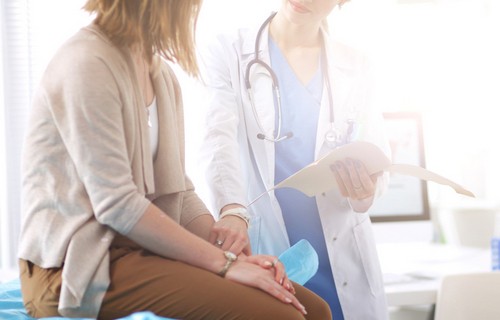Any of these symptoms is not the norm. If you experience discomfort during your period, consult your gynecologist as soon as possible.
Endometriosis, which does not manifest itself in any way, is most often diagnosed by chance – for example, during examination during pregnancy planning.
Doctors sometimes find endometriosis when they try to establish the cause of infertility.
In all other cases, it’s enough to listen to your feelings and keep track of signs that help suggest that you may have endometriosis.
- Painful periods – pain and cramping in the pelvic area begin a few days before the onset of menstrual bleeding and continue after they begin. Sometimes the lower back and stomach hurts, there are discomfort when visiting the toilet.
- Painful sex – discomfort during and after sex.
- Excessive bleeding – heavy periods, sometimes bleeding occurs between menstruation.
- Feeling unwell during menstruation – weakness, indigestion, bloating and nausea.
It is important to understand that the diagnosis of endometriosis is a difficult task . Laboratory “testing for endometriosis,” No , and ultrasound and MRI helps not always. After examination at the first appointment, the gynecologist can only suspect that you may have endometriosis. The only way to make an accurate diagnosis is to perform a laparoscopic operation .

Endometriosis is a condition in which cells, normally lining the inside of the uterus, begin to grow outside. The internal mucous membrane of the uterus is called endometrium – hence the name.
Most often, “migrant cells” are embedded in the tissues of the ovaries, uterus and fallopian tubes, sometimes they enter other organs of the small pelvis, for example, in the intestine or in the bladder. But even by “changing residence”, the cells continue to obey the hormones that control the female cycle. During menstruation, migrated cells are rejected in the same way as normal endometrial cells, which remain in place. There is one important difference: endometriosis cells cannot leave the body with menstrual blood.
Sometimes rejected cells cause small bleeding inside the pelvis. In the place where the blood got, inflammation occurs, with which the body successfully copes. As a result, the woman either does not feel anything at all, or experiences mild abdominal pain, which quickly passes. But if the cells are embedded in the ovarian tissue, cysts can begin to grow on the organ – formations from the connective tissue filled with menstrual blood. Cysts can grow more than six centimeters in length, cause severe pain and cause infertility.
Endometriosis is one of the five most common gynecological disorders – after benign diseases of the cervix, menstrual disorders, inflammatory diseases of the urogenital tract and infertility.
In our country, the incidence of endometriosis is steadily increasing. Today, the disease is diagnosed in almost 400 out of 100 thousand Russians who came to see a gynecologist. Perhaps the fact is that the diagnostic methods have improved, and the problem has begun to receive more attention.
Six important facts about endometriosis
- Endometriosis is at one in ten women aged 15-49 years. This is approximately 176 million women worldwide.
- Endometriosis can occur at any age, but most often young active women 30-40 years old suffer .
- Endometriosis can occur without symptoms, and can be painful – up to the inability to work and learn normally.
- Endometriosis is very difficult to diagnose. Some women find out about their condition only after 6-10 years after the first visit to a doctor.
- Endometriosis is not a precursor to ovarian cancer. Cancer develops only in 0.3-0.8% of women with endometriosis.
- With endometriosis, they rarely go to the doctor , because both patients and even some gynecologists believe that severe pain during menstruation is normal.
Why does endometriosis occur?
No one knows . According to the most popular version , endometrial cells enter the abdominal cavity along with menstrual blood. But this hypothesis does not explain why endometriosis occurs in girls whose menstruation has not yet begun.
In some families, endometriosis is more common than in others, so the reason may be in genetics . And also endometrial cells are able to “grow” into the surgical suture , which remained after cesarean section and other operations.
Risk Factors for Endometriosis
- endometriosis in a close relative: mother, sister or daughter;
- early onset of menstruation: up to 11 years;
- short monthly cycles: less than 27 days;
- heavy menstrual bleeding that lasts longer than a week.
Factors that reduce the risk of endometriosis
- pregnancy;
- the beginning of menstruation at the end of the teenage period: at 13-15 years;
- regular exercise: more than four hours a week;
- low body mass index: BMI in the range of 16-18.5.
What is dangerous endometriosis
The well-being of a woman with endometriosis depends on the stage of the disease, on which organ the cells from the uterus “embedded” in, whether there are cysts, how many they are and what size they are. But here, everything is not so simple: women with large cysts may have mild symptoms, and women with small ones may have severe symptoms.
Nevertheless, it is believed that if a woman has no complaints, treatment of endometriosis is not necessary . But there are other situations. Sometimes women experience such severe pain that drug therapy is necessary and surgery may be required. If you leave the problem unattended, the condition may gradually worsen – up to damage to internal organs.
Endometriosis can significantly reduce the quality of life and lead to dangerous complications.
Among them:
- severe menstrual pain;
- heavy uterine bleeding;
- infertility. Moreover, often the disease is detected only at the stage of unsuccessful pregnancy planning.
What complications may result from endometriosis?
Infertility. In some women, endometriosis can cause fertility problems . According to some reports, from 30 to 50% of women who have been diagnosed with the disease suffer from infertility . It is believed that this is due to damage to the fallopian tubes or ovaries.

Bladder problems and bowel obstruction. If endometrioid cells “integrate” into the bladder or intestines, a complex operation may be required , which is very difficult to recover from.
Can endometriosis be cured
Cure for endometriosis does not exist , and to prevent it can not be . But you can reduce the chances of developing endometriosis, successfully deal with pain and overcome the problems that it causes, including infertility.
You can reduce the chances of developing endometriosis if you follow simple recommendations .
- Talk to your doctor about hormonal contraceptive methods. Patches, tablets and vaginal rings not only help to avoid pregnancy, but can also work as a medicine to combat the symptoms of endometriosis. The main thing is to choose the right contraceptive. This is not possible without the help of a doctor.
- Go in for sports. Regular exercise over four hours a week helps lower your body mass index (BMI), and a high BMI is one of the risk factors for developing endometriosis.
- Avoid alcohol. Alcohol increases estrogen levels in the blood, which increase the symptoms of endometriosis. Try to drink no more than one alcoholic drink per day.
- Avoid caffeinated drinks. In some women, caffeine increases estrogen levels in the body, so try to drink no more than one caffeinated drink per day. These are coffee, carbonated energies and green tea.
Pain control and hormonal contraceptives help control pain in endometriosis , and surgical treatment may be necessary for severe endometriosis. However, it is important to understand that surgery does not always help – sometimes it is safer and more reliable to control the disease with medication.
Endometriosis should not be treated by all and not always.
Most often, therapy is required in the presence of clinical manifestations or complications of endometriosis:
- severe pain syndrome;
- abnormal uterine bleeding;
- infertility.
If the patient has no symptoms, and signs of endometriosis are revealed by ultrasound, most often treatment is not necessary.
Infertility treatment for endometriosis begins with the help of special drugs. If this does not help, or if the endometriotic “sprawl” interferes with normal pregnancy, surgery may be required. If this does not help, the doctor may recommend in vitro fertilization.
What is the result
- Endometriosis is a condition in which cells of the internal mucous layer of the uterus – the endometrium – grow in the wrong place. Due to the fact that during menstruation these cells are rejected, internal bleeding occurs or blood-filled cysts form.
- Endometriosis is common, but manifests itself in different ways. Endometriosis can either not cause unpleasant symptoms at all, or provoke excruciating pain. One of the common complications of endometriosis is infertility.
- Many women consider pain during menstruation to be the norm, and therefore do not go to the doctor. As a result, endometriosis can be diagnosed only 10 years after the start of the process.
- Menstruation pain is not the norm. If you experience unpleasant sensations, you should contact your gynecologist as soon as possible.
- Endometriosis cannot be cured or prevented, but can be controlled. Timely treatment prescribed by an experienced doctor can relieve pain. Infertility associated with endometriosis is also treatable.



